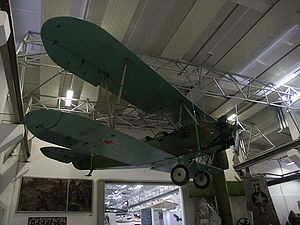Polikarpov Po-2
| Po-2 "Kukuruznik" | |
|---|---|
 |
|
| A Po-2 at a museum in Dresden, Germany | |
| Role | Utility biplane |
| Manufacturer | Polikarpov |
| First flight | 24 June 1927 |
| Introduction | 1929 |
| Primary users |
Soviet Air Force Aeroflot DOSAAF |
| Produced | 1928-1952 |
| Number built | 20,000–30,000 |
The Polikarpov Po-2 (also U-2) served as a general-purpose Soviet biplane, nicknamed Kukuruznik (Russian: Кукурузник, from Russian "kukuruza" (кукуруза) for maize; thus, "maize duster" or "crop duster"), NATO reporting name "Mule". The reliable, uncomplicated concept of the Po-2's design made it an ideal training aircraft, as well as doubling as a low-cost ground attack, aerial reconnaissance, psychological warfare and liaison aircraft during war, proved to be one of the most versatile light combat types to be built in the Soviet Union. As of 1978 it remained in production for a longer period of time than any other Soviet-era aircraft.
It is one of the most produced aircraft, and may be the most produced biplane with production possibly as high as 30,000 Po-2s built between 1928 and 1959. However, production figures for Polikarpov U-2 and Po-2 bombers and trainers combined are between 20,000 and 30,000. with production ending as early as 1952. Correct figures are hard to come by since low-rate production by small repair shops and air clubs likely continued until 1959.
The aircraft was designed by Nikolai Polikarpov to replace the U-1 trainer (a copy of the British Avro 504), itself known as Avrushka to the Soviets. Its name was changed to Po-2 in 1944, after Polikarpov's death, according to the new Soviet naming system, usually using the first two letters of the designer's family name, or the design bureau that created it.
The prototype of the U-2, powered by a 74 kW (99 hp) Shvetsov M-11 air-cooled five cylinder radial engine, first flew on 7 January 1928 piloted by M.M. Gromov. Aircraft from the pre-production series were tested at the end of 1928 and serial production started in 1929 in Factory number 23 in Leningrad. Production in the Soviet Union ended in 1953, but license-built CSS-13 were still produced in Poland until 1959.
...
Wikipedia
